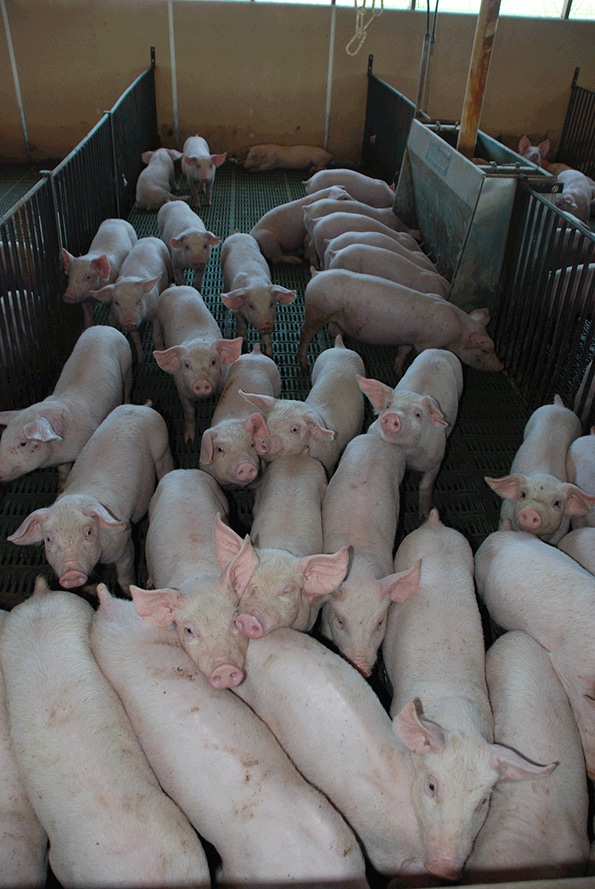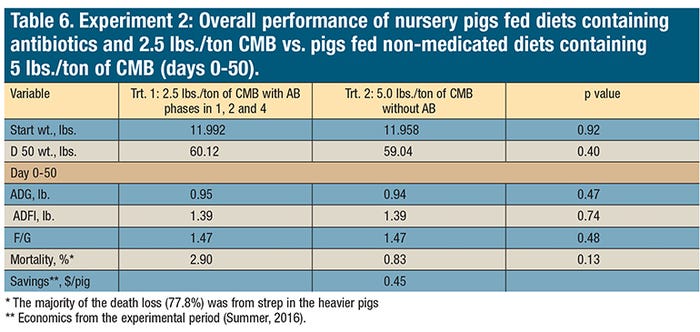Data support the use of a commercial blend of medium-chain fatty acids and other functional components as an efficient tool to improve nursery pig performance when pigs are fed diets with or without antibiotics.
October 16, 2017

By D. McManus, M. Lachmann, T. Weeden, B. de Rodas and S. Crowder, Purina Animal Nutrition; and S. Petersen, PMI Feed Additives
Research shows commercial blends of medium-chain fatty acids are an efficient tool to improve nursery pig performance when pigs are fed diets with or without antibiotics.
In North America, public concern regarding the use of antibiotics in pork production has grown over the last years. The human medicine segment is looking into animal production practices that can contribute to reducing the risk of proliferation of resistant bacteria in the environment. As a result, since Jan. 1, 2017, all medically important antimicrobials intended for use in swine feed that were previously available “over the counter” require a veterinary feed directive. Consequently, the swine industry is working on the design and evaluation of feed additives, feeding programs, and management practices to support animal growth and health without the use of antibiotics.
Feed additives are not designed to provide nutrient density to the diet; they provide functional components to support production efficiency and pig performance. To be considered effective, the feed additive must provide a performance improvement equivalent to the added cost or maintain animal performance at a lower cost (improve pig production and profitability).
Medium-chain fatty acids, acidifiers, prebiotics, probiotics and botanicals in swine diets have been considered as options to support the gut health, the immune system and, subsequently, performance. Prior trials (unpublished Purina Animal Nutrition research) have indicated the effectiveness of a commercial blend (CMB) of MCFA with other functional components in improving the performance of nursery pigs. Two experiments were conducted to evaluate the effect of feeding the commercial blend on nursery performance of pigs raised with or without antibiotics.
Material and methods
Experiment 1 was conducted with the objective of evaluating the effect of feeding CMB at three levels (0, 2.5 and 5 pounds per ton) within the complete feed on pig performance when pigs were fed diets containing antibiotics during the nursery period. To achieve this objective, a total of 660 pigs were allotted to one of three dietary treatments (20 pigs per pen with 11 replicates).
Antibiotics were used as follows for all treatment groups:
■ a combination of tiamulin hydrogen fumarate at 35 grams per ton and chlortetracycline at 400 grams per ton in phases 1 and 2
■ 50 grams per ton of Carbadox in phase 3
■ Chlortetracycline at 500 grams per ton in phase 4
All feeding programs were similar in nutrient composition and functional components, except treatment 1 consisted of a control diet without CMB, treatment 2 consisted of a similar feeding program to treatment 1, except CMB was added at a rate of 2.5 pounds per ton of complete feed, and treatment 3 was similar to treatment 1, except CMB was added at a rate of 5 pounds per ton of complete feed (see Table 1).

Experiment 2
Experiment 2 was conducted to compare the performance of the pigs fed under programs containing antibiotics in combination with CMB at 2.5 pounds per ton versus the performance of nursery pigs raised without antibiotics in combination with 5 pounds per ton of CMB (as an alternative antibiotic-free program). To achieve this objective, a total of 442 pigs were allotted to one of two dietary treatments (22 pigs per pen with 11 replicates).
Treatment 1 consisted of a four-phase feeding program with the inclusion of 2.5 pounds per ton of CMB in addition to antibiotics in phases 1, 2 and 4 (based on the best-performing treatment from experiment 1).
Treatment 2 consisted of a similar feeding program to treatment 1 with the exception that CMB was added at a rate of 5 pounds per ton without the use of antibiotic in the feed (alternative antibiotic-free feeding program).
The antibiotic protocol used in treatment 1 was: Tiamulin hydrogen fumarate at 200 grams per ton in phase 1; a combination of tiamulin hydrogen fumarate at 35 grams per ton and chlortetracycline at 400 grams per ton in phase 2; no medication in phase 3; repeated tiamulin hydrogen fumarate and chlortetracycline combination in phase 4.
Both feeding programs were similar in nutrient composition and included other functional components currently used in the Purina Animal Nutrition lactose-free nursery pig feed program.
The two dietary treatments were designed to be fed in four phases during a 43-day period following a feeding budget of 10 pounds of feed per pig in phase 1 and phase 2 and 20 pounds of feed per pig in phases 3 and 4, respectively. However, not all the feed was consumed by Day 43. Therefore, pigs were fed until Day 50 (see Table 2).

In experiments 1 and 2, pigs had free access to feed and water. Production performance parameters including initial and final pig body weight, pen feed consumption, pen weight and mortality were measured and recorded weekly. Weight gain and feed: gain ratio were calculated. All the collected data were analyzed using the mixed procedure of SAS.

Results and discussion
In experiment 1, the best performance and economic return was obtained (see tables 3 and 4) when pigs were fed diets containing 2.5 pounds per ton of CMB with antibiotics (treatment 2).
These pigs were:
■ 1.98 pounds heavier (p=0.09) when compared to pigs raised with antibiotics and not fed CMB
■ 0.98 pound heavier (p=0.09), when compared to pigs fed diets containing antibiotics and CMB at 5 pounds per ton of complete feed.
Additionally, this group of pigs used 0.08 pound less feed (p<0.01) per each pound of body weight gained when compared to the control pigs (7.8 points). These results indicated the most efficient level of CMB was 2.5 pounds per ton of feed in combination with antibiotics to improve pig performance.
The next step to identify an effective alternative feeding program was to compare the nursery performance of pigs fed a feeding program with antibiotics and 2.5 pounds of CMB per ton of complete feed across all nursery diets versus an alternative feeding program for pigs raised without antibiotics (using CMB at 5 pounds per ton of feed). This was the approach used in experiment 2.

Experiment 2
There was no significant difference in pig performance between pigs that were fed CMB at 5 pounds per ton in non-medicated diets compared to those fed a program with antibiotics and 2.5 pounds of CMB (tables 5 and 6).
However, these results indicated a strong numerical trend (p = 0.06) for improved F:G between days 0 to 43 when pigs were fed antibiotics in combination with 2.5 pounds per ton of CMB.

Conclusions
The results of these studies indicate adding CMB at a rate of 2.5 pounds per ton of complete feed improved performance of nursery pigs fed diets containing antibiotics.
The results also indicate pigs fed diets containing 5 pounds per ton of CMB and no antibiotics had similar gains and feed conversion to those fed diets containing antibiotics and 2.5 pounds per ton of CMB during days 0 to 50 post-weaning.
The data support the use of a commercial blend of medium-chain fatty acids and other functional components as an efficient tool to improve nursery pig performance when pigs are fed diets with or without antibiotics.

You May Also Like



